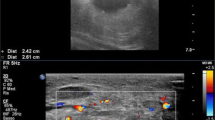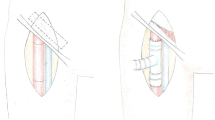Abstract
A 74-year-old man presented with a ruptured infected anastomotic femoral pseudoaneurysm. Due to severe medical comorbidities he was considered unsuitable for conventional surgical management and underwent an emergency endovascular repair with a balloon-expandable covered stent. The pseudoaneurysm was excluded successfully and the patient had an uneventful postoperative recovery with long-term suppressive antimicrobials. He remained well for 10 months after the procedure with no signs of recurrent local or systemic infection and finally died from an acute myocardial infarction. To our knowledge, emergency endovascular treatment of a free ruptured bleeding femoral artery pseudoaneurysm has not been documented before in the English literature. This case illustrates that endovascular therapy may be a safe and efficient alternative in the emergent management of ruptured infected anastomotic femoral artery pseudoaneurysms when traditional open surgery is contraindicated.



Similar content being viewed by others
References
Demarche M, Waltregny D, van Damme H, et al. (1999) Femoral anastomotic aneurysms: Pathogenic factors, clinical presentations and treatment. A study of 142 cases. Cardiovasc Surg 7:315–322
Brountzos EN, Malagari K, Gougoulakis A, et al. (2000) Common femoral artery anastomotic pseudoaneurysm: Endovascular treatment with Hemobahn stent-grafts. J Vasc Interv Radiol 11:1179–1183
Baril DT, Ellozy SH, Carroccio A, et al. (2004) Endovascular repair of an infected carotid artery pseudoaneurysm. J Vasc Surg 40:1024–1027
Sanada J, Matsui O, Arakawa F, et al. (2005) Endovascular stent-grafting for infected iliac artery pseudoaneurysms. Cardiovasc Intervent Radiol 28:83–86
van den Akker PJ, Brand R, van Schilfgaarde R, et al. (1989) False aneurysms after prosthetic reconstructions for aortoiliac obstructive disease. Ann Surg 210:658–666
Derom A, Marcoen S, Vermassen F, et al. (2001) Treatment of ruptured anastomotic aneurysm by endograft. J Cardiovasc Surg (Torino) 42:97–99
Seabrook GR, Schmitt DD, Bandyk DF, et al. (1990) Anastomotic femoral pseudoaneurysm: An investigation of occult infection as an etiologic factor. J Vasc Surg 11:629–634
Ting AC, Cheng SW, Ho P, et al. (2006) Endovascular stent graft repair for infected thoracic aortic pseudoaneurysms: A durable option? J Vasc Surg 44:701–705
Kwon K, Choi D, Choi SH, et al. (2002) Percutaneous stent-graft repair of mycotic common femoral artery aneurysm. J Endovasc Ther 9:690–693
Clarke MG, Thomas HG, Chester JF (2005) MRSA-infected external iliac artery pseudoaneurysm treated with endovascular stenting. Cardiovasc Intervent Radiol 28:364–366
Therasse E, Soulez G, Cartier P, et al. (1994) Infection with fatal outcome after endovascular metallic stent placement. Radiology 192:363–365
Benjamin ME, Cohn EJ Jr, Purtill WA, et al. (1999) Arterial reconstruction with deep leg veins for the treatment of mycotic aneurysms. J Vasc Surg 30:1004–1015
Kurimoto Y, Tsuchida Y, Saito J, et al. (2003) Emergency endovascular stent-grafting for infected pseudoaneurysm of brachial artery. Infection 31:186–188
Bergamini TM, Bandyk DF, Govostis D, et al. (1988) Infection of vascular prostheses caused by bacterial biofilms. J Vasc Surg 7:21–30
Edmiston CE Jr, Goheen MP, Seabrook GR, et al. (2006) Impact of selective antimicrobial agents on staphylococcal adherence to biomedical devices. Am J Surg 192:344–354
Stricker H, Jacomella V (2004) Stent-assisted angioplasty at the level of the common femoral artery bifurcation: Midterm outcomes. J Endovasc Ther 11:281–286
Author information
Authors and Affiliations
Corresponding author
Rights and permissions
About this article
Cite this article
Klonaris, C., Katsargyris, A., Matthaiou, A. et al. Emergency Stenting of a Ruptured Infected Anastomotic Femoral Pseudoaneurysm. Cardiovasc Intervent Radiol 30, 1238–1241 (2007). https://doi.org/10.1007/s00270-007-9080-z
Received:
Revised:
Accepted:
Published:
Issue Date:
DOI: https://doi.org/10.1007/s00270-007-9080-z




